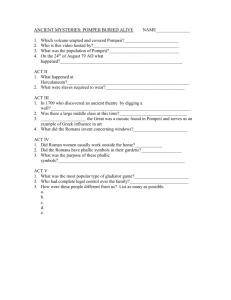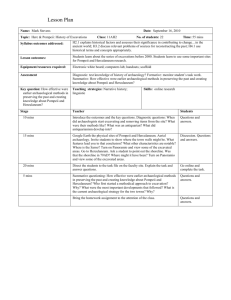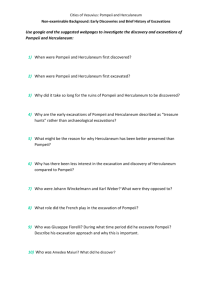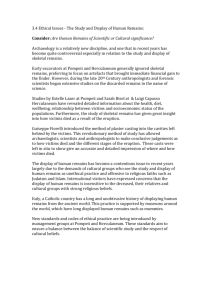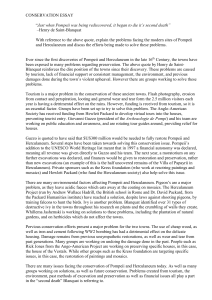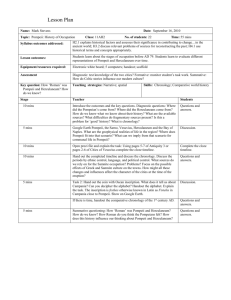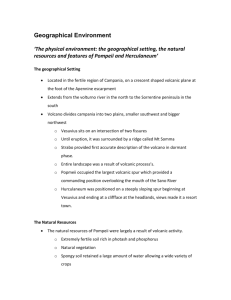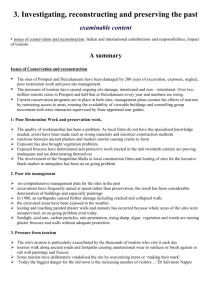Pompeii and Herculaneum - ANCIENT HISTORY SEMINARS
advertisement
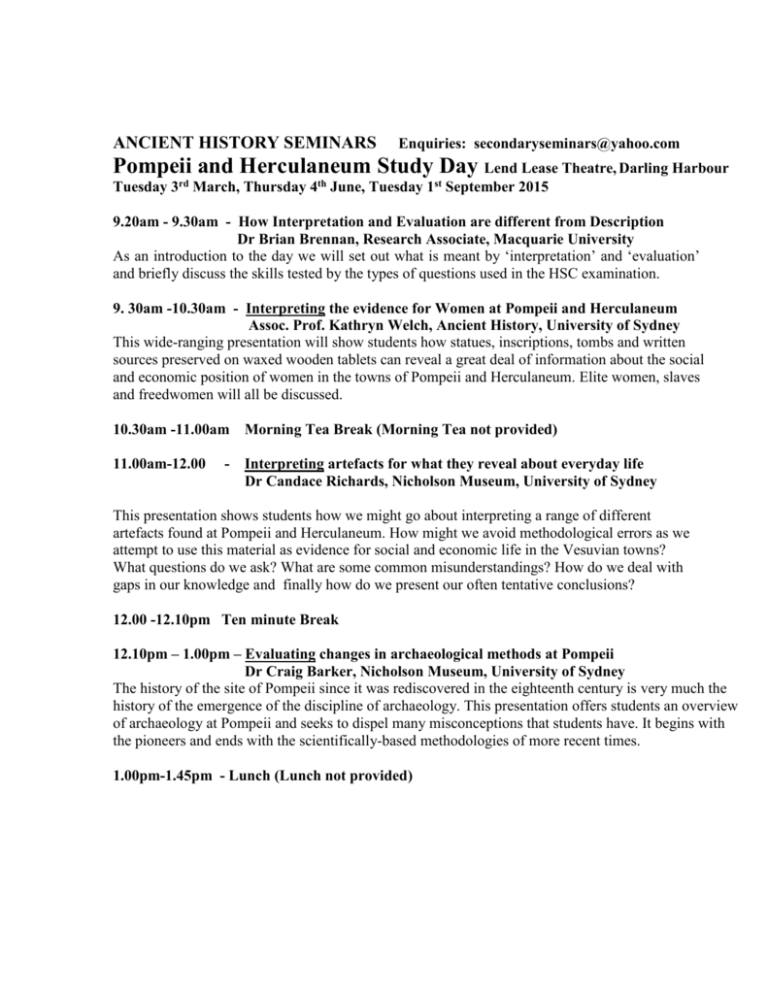
ANCIENT HISTORY SEMINARS Enquiries: secondaryseminars@yahoo.com Pompeii and Herculaneum Study Day Lend Lease Theatre, Darling Harbour Tuesday 3rd March, Thursday 4th June, Tuesday 1st September 2015 9.20am - 9.30am - How Interpretation and Evaluation are different from Description Dr Brian Brennan, Research Associate, Macquarie University As an introduction to the day we will set out what is meant by ‘interpretation’ and ‘evaluation’ and briefly discuss the skills tested by the types of questions used in the HSC examination. 9. 30am -10.30am - Interpreting the evidence for Women at Pompeii and Herculaneum Assoc. Prof. Kathryn Welch, Ancient History, University of Sydney This wide-ranging presentation will show students how statues, inscriptions, tombs and written sources preserved on waxed wooden tablets can reveal a great deal of information about the social and economic position of women in the towns of Pompeii and Herculaneum. Elite women, slaves and freedwomen will all be discussed. 10.30am -11.00am Morning Tea Break (Morning Tea not provided) 11.00am-12.00 - Interpreting artefacts for what they reveal about everyday life Dr Candace Richards, Nicholson Museum, University of Sydney This presentation shows students how we might go about interpreting a range of different artefacts found at Pompeii and Herculaneum. How might we avoid methodological errors as we attempt to use this material as evidence for social and economic life in the Vesuvian towns? What questions do we ask? What are some common misunderstandings? How do we deal with gaps in our knowledge and finally how do we present our often tentative conclusions? 12.00 -12.10pm Ten minute Break 12.10pm – 1.00pm – Evaluating changes in archaeological methods at Pompeii Dr Craig Barker, Nicholson Museum, University of Sydney The history of the site of Pompeii since it was rediscovered in the eighteenth century is very much the history of the emergence of the discipline of archaeology. This presentation offers students an overview of archaeology at Pompeii and seeks to dispel many misconceptions that students have. It begins with the pioneers and ends with the scientifically-based methodologies of more recent times. 1.00pm-1.45pm - Lunch (Lunch not provided) 1.45pm - 2.30pm - Evaluating work done on the Villa of the Papyri at Herculaneum: from Weber to the controversial recent work by Simone and Ruffo Dr Brian Brennan An opportunity for students to learn about the latest research on this significant villa. Starting with the Bourbon tunnellers this presentation goes on to critically examine the exploration and mapping of the villa made by the 18th century Swiss engineer Karl Weber. The contents are considered and the ownership of the villa debated. We then turn to the recent work by Antonio de Simone and Fabrizio Ruffo which both revealed previously unknown parts of the villa and ignited controversy. We end by looking at the John Paul Getty reconstruction of the villa in Malibu, CA. Notes: Students will be supplied with maps, plans, notes related to the presentations Study Day Presenter: Dr Brian Brennan is a historian who has taught in schools, TAFE colleges and universities. Currently he is a Research Associate in Ancient History at Macquarie University and leads tours to ancient sites for the University of Sydney. He has conducted tours for HSC students to Rome, Pompeii and Herculaneum and led other tours to Roman sites in Algeria, Tunisia, Libya and Jordan. Among his publications are HSC text books: Pompeii and Herculaneum Interpreting the Evidence (with Estelle Lazer) 2005, Spartan Society Interpreting the Evidence 2007, Minoan Society Interpreting the Evidence 2009, Herculaneum A Sourcebook 2012 and Cities of Vesuvius Interpreting the Evidence 2013. 10.40am -11.25am – Interpreting the skeletons from the House of Julius Polybius The House of Julius Polybius is known to many students from the BBC documentary “Pompeii, the Last Day” and this presentation seeks to separate fantasy from fact. It focuses then on the work of Prof. Marciej Henneberg and Dr Renata Henneberg (Univ of Adelaide) who have studied the 13 skeletons rom the house. It concludes with the latest breakthrough work on the DNA (April 2009) that proves familial connection for some of the individuals in sample. This is valuable information for students interested in changing methods of interpretation and the impact of new techniques. ANCIENT HISTORY SEMINARS PROGRAM 2011 YEAR 11: Friday 11th March History, Archaeology and Science Year 11 Year 12: Thur 8th March CORE: Pompeii and Herculaneum Year 12 Wed 26th May Extension Historiography Year 12 Tues 7th June Sparta: the archaeological evidence Thur 14th June CORE: Pompeii and Herculaneum Fri 17th June Minoan Society: the latest work All enquiries about the availability of places by email: secondaryseminars@yahoo.com Year 12 Year 12 Year 12 12.15pm – 1.00pm Interpreting tombs and funerary practices SKELETAL MATERIAL from HERCULANEUM The work of Sara Bisel 1982 – 1988 Context (1) (2) The significance of Bisel’s work: (1) (2) Some of her findings: (1) (2) Helen Nicholson (3) Some Criticisms of her work (1) (2) (3) (4) The significance of the most recent work by Luigi Capasso, published in 2001 (1) (2) (3) THE FOUR ‘POMPEIAN’ PAINTING STYLES The four ‘styles’ were categorized by the German archaeologist August Mau in his History of Decorative Wall Painting in Pompeii published in 1882. The four styles are used by archaeologists to (1)…………………………………………………….. and (2) ……………………………………………… CHARACTERISTICS OF THE ‘FIRST STYLE’ * * * DATE: CHARACTERISTICS OF THE ‘SECOND STYLE’ * * * DATE: CHARACTERISTICS OF THE ‘THIRD STYLE’ * * * * DATE: CHARACTERISTICS OF THE ‘FOURTH STYLE’ * * * DATE: Criticism of the concept of the Four Styles * * MOSAICS Greek Origins of Mosaic Traditions * * Roman Development Tesserae: Use of Mosaics in houses and public Pompeii and Herculaneum Examples: (1) (2) (3) (4) Do mosaics show scenes from everyday life at Pompeii? What do the mosaics reveal about the people who put them in their houses? The Battle of Alexander Mosaic in the House of the Faun, Pompeii Depicts: Context: The ‘message’ was………………… THE HERCULANEUM CONSERVATION PROJECT, begun in 2001, is a collaboration between (1) (2) The aims of the project: (1) (2) (3) Some important work undertaken in 2006 - 2007 (1) (2) (3) (3) (4) (5) Why is the project significant ? FIND OUT MORE: www.herculaneum.org.
